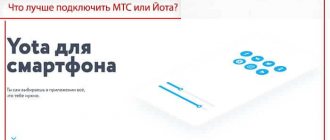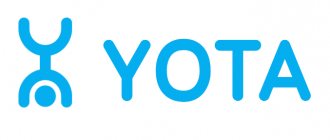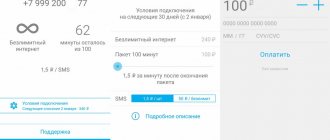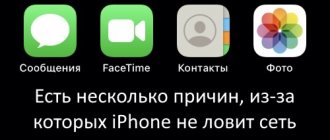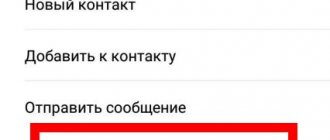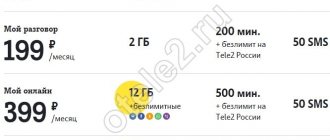The operators MegaFon and Yota became one in July 2012, when MegaFon PJSC and Scartel LLC decided to merge their assets. Before this they worked separately. Yota itself appeared in 2007 as an operator of WiMAX networks in St. Petersburg, Moscow and Ufa. In mid-2009, test operation of the networks became commercial. Next year Yota begins to launch LTE networks. In July 2012, the above companies merged. And since 2014, Yota has become a federal cellular operator.
It is safe to say that Iota is MegaFon. It uses its base stations, but in some regions it has its own BS operating in the 4G standard. In some places, the operator uses Rostelecom towers. Having installed the SIM card in the phone, we can notice how the name of the operator changes - the inscription “Yota” or “Rostelekom” lights up on the display. But the inscription “MegaFon” never appears.
Since MegaFon and Yota are one and the same, there is an almost complete coincidence of network coverage areas. There are some differences, but in most cases Yota will work where MegaFon has coverage. In some cases, in some localities SIM cards for smartphones and tablets work, but SIM cards for modems do not work. To clarify these points, please refer to the coverage map on the operator’s website.
Yota cooperation with Megafon
The cooperation of these companies began in 2012, when Megafon bought shares of Scartel, which at that time owned the Yota brand.
Up to this point, the young mobile operator has been developing and growing, replacing old technologies with new ones and increasing its own coverage. The merger with a larger player made it possible to significantly improve the quality of the services provided, and also, no matter how paradoxical it may sound, to gain its own individuality. Megafon itself positions itself as a traditional mobile operator.
It, unlike its subsidiary, has service and entertainment services. Its subscribers can make money transfers, geopositioning, change the dial tone, and the like. It is worth noting the fact that Megafon has many more tariff plans.
Early stage of activity.
The path to success was neither easy nor quick. Initially, major figures in the communications market did not want to take the new company seriously, and it cannot be said that their opinion was completely unfounded. According to the recollections of the company’s vice president for business development, Egor Ivanov, at the start the company had three employees, all wearing sneakers. Their youth and hipster, somewhat rebellious aura both attracted attention and caused some concern. For example, Egor Ivanov talks about his visit to the office of the South Korean company Samsung like this: “They didn’t understand what to talk about with these strange Russian people. We didn’t even have business cards.” Despite such a difficult start, over time the company proved that it is quite serious and worthy of trust.
A little history and subtleties
In fact, we can say that Yota is MegaFon. In 2012, they entered into official cooperation (combined assets), and in 2014, Iota launched as a virtual mobile operator. The coverage areas of the two operators are almost the same, with the exception of a few cities in which MegaFon managed to install LTE Band 20 networks. In such places, Yota does not operate in 4G format.
Yota is indeed a subsidiary of MegaFon, but it is not the same thing. Yota retain their specificity and concept of a virtual operator, while using MegaFon equipment. Yota operates from its towers, which it owned before the merger, and from the towers of its parent company. Before this, shares in Yota belonged to Scartel, which was bought by the famous operator.
In fact, Yota is MegaFon. If we dig a little deeper, we will find that in 2014 Iota established itself as a virtual cellular operator. Cooperation with MegaFon, expressed in the combination of assets, occurred in July 2012. Their coverage areas coincide almost completely, with the exception of some cities in which MegaFon has built LTE Band 20 networks - Yota does not work here (in 4G format).
Yota is a subsidiary of MegaFon, but it is not one company. Yota is a virtual operator that uses the equipment of its parent company. Therefore, the question of whose towers Yota uses is very easy to answer - Yota uses MegaFon’s towers and its own towers that were available before the merger of assets.
MegaFon bought Yota by purchasing shares of Scartel. There was information in the media that the Yota brand would be destroyed, but today we see that this is not the case - the subsidiary works as a virtual operator and belongs to the organization that bought it. Roughly speaking, now this is almost one company, but the brands have different areas of activity.
Expert reviews on the work of virtual operators
Both companies use the same networks, and their voice quality is approximately the same. As a result, the choice should be made in favor of certain tariffs and options. Everything here is ambiguous, and everyone decides for themselves what suits them.
Features of the network and speed of Iota and Megafon are discussed in the video:
Iota is more convenient in terms of selecting TP. Megafon, instead, offers a variety of pricing options, focusing on different needs and types of customers.
Iota is MegaFon or not
In terms of tariffs, Yota is more limited, because it is focused exclusively on the Internet. The difference in tariffs will depend on the choice of device (tablet, mobile phone or PC), as well as the desired speed. In this field, the operator provides its subscriber with a huge choice between two dozen different speed levels.
Often, a cellular operator is chosen based on the services it provides, that is, a suitable tariff plan is selected. It is worth noting that Megafon and Yota provide services in the form of package offers, that is, a certain set of minutes for talking, a megabyte for surfing the Internet, sending free messages, and the like. In this case, the user himself decides which services to include in the package.
To make comparison easier, the sample will consist of the most budget tariffs. The result was the following:
- Iota – 250 minutes and 1 GB of Internet for 250 rubles per month. As for messages, they are not included in the package and are paid separately. Also, this package does not include unlimited applications.
- Megafon – 400 minutes, 6 GB, 100 messages, unlimited on Viber, WhatsApp and eMotion for 300 rubles per month.
More about Yota: Buy a Yota SIM card for your phone
It may immediately seem that Megafon is many times more profitable, because by overpaying only 50 rubles, you can get unlimited use of Internet applications, 100 free messages, six times more gigabytes for surfing the Internet and almost twice as many free call minutes. And it's actually a good deal if you take advantage of all of this. However, the situation changes dramatically if you don’t need the same Viber, and you don’t write messages to anyone.
There is a fairly widespread opinion that Yota and MegaFon are the same operator. Legally, they are the same, but practically, they perform different functions. MegaFon is considered a traditional mobile operator. Yota, in turn, plays the role of a virtual operator, one of the main vectors of which is the provision of unlimited Internet.
MegaFon and Yota have the same coverage area, but different tariffs. The answer to the question of which of them is better is very difficult. It depends on what the subscriber himself expects from the tariff plan. For example, Yota provides absolutely unlimited traffic for accessing the Internet from a computer (unlike MegaFon). The quality of voice calls is basically the same for both operators.
MegaFon is great for those who value high-quality voice calls and high-speed Internet on their smartphone. A series of “Turn On” tariff plans have been developed especially for this category of subscribers, which can satisfy any needs.
Yota offers its subscribers tariff plans in three categories: for smartphones, tablet PCs and routers/modems. A single tariff has been developed for cell phones - capacious and flexible. The minimum option is 200 minutes for calls to Russian numbers and 2 GB of Internet traffic. Cost - 370 rubles per month. The maximum version will cost subscribers 2,850 rubles every month for 5,000 minutes and 30 GB of Internet.
Many people believe that Yota and MegaFon are one and the same. This is not to say that this is not the case, but the positioning of brands is still different. MegaFon remains a traditional operator, while Yota is virtual and focuses on unlimited Internet. Today this Internet is available only on tablet PCs and modems/routers. Until January 25, 2021, unlimited was also available on smartphones, but then it was removed.
MegaFon and Yota are almost identical in coverage area, but differ in tariffs. Therefore, it is very difficult to answer which is better - it all depends on the preferences of the subscriber. For example, if you need unlimited mobile Internet from your computer, you should choose Iota without hesitation - MegaFon does not have complete unlimited data. In terms of voice quality, both operators are almost identical.
If you need high-quality voice communications and fast Internet on your smartphone, we recommend taking a closer look at MegaFon's tariff plans. It operates a profitable “Turn On!” line, offering subscribers several tariff plans for any needs.
Let's take a look at what Yota offers us (or Eta is an erroneous but common spelling of the operator's name). Its tariffs are divided into three categories - for smartphones, tablets and modems/routers. Smartphones have a single tariff plan, and it is very flexible. The minimum subscription fee is 370 rubles/month. – it includes 200 minutes within Russia and 2 GB of traffic. A package of 5,000 minutes and 30 GB of traffic will cost 2,850 rubles/month.
The beginning of acquaintance with the operators began as usual. In both cases, tariffs are presented in the form of package offers that provide a certain set of minutes, gigabytes and additional features.
To begin with, we decided to consider the most budget options, setting all the settings to the minimum, we got the following values:
- Iota - 250 minutes and 1 gigabyte of Internet for 250 rubles. Messages are charged separately, and you don’t have to think about unlimited applications.
- Megafon - 400 minutes, 6 gigabytes, 100 SMS, unlimited Viber, WhatsApp and eMotion for 300 rubles.
More about Yota: Bypassing Yota restrictions: Internet distribution, Internet speed
Internet
As for connecting to the Internet, it is financially and technically advantageous to cooperate with Yota:
- The client pays for speed; there is no limit on data transfer.
- At any time, he can reduce this parameter, extending the paid service for a longer period.
- If the funds run out, he can access the Internet for free at a speed of 64 kbit/sec. The indicator is small, but it is enough to send a message in instant messengers.
The data transfer settings are very subtle and can be changed in the application. The user has the right to choose which services are more preferable to him and to enable separate options for them. For example, unlimited on YouTube, Instagram, Vkontakte. Everything that he does not need can be excluded from the range of services. Conclusion: no one on the market offers better conditions than Iota.
Video about how Yota’s tariff setting system works:
Megafon, like other large communications companies, offers to use the paid limit, which is usually used up before the end of the month. After this, the network is disconnected, and the client is sent an SMS to the number and offered to pay for additional traffic. Iota is better in this regard: when the standard limit is used up, you can still access the Internet at minimum speed while continuing to conduct text correspondence.
The same applies to tariffs with options for unlimited use of any messenger or service. For example, Megafon included unlimited use of YouTube in the tariff for 1,000 rubles per month. For comparison, Yota offers to do the same by connecting the opportunity for 100 rubles.
Yota does not offer other paid services, much less impose anything, like Megafon. Therefore, the risk of becoming a victim of fraudsters is minimal.
Although Megafon has more stable data transmission, since the company has greater network coverage. This is especially noticeable when leaving a populated area. Plus, you need to remember the limitations of a 4-G connection: where a Yota subscriber automatically connects to 3-G, Megafon guarantees full LTE.
TP “Turn on! Communicate"
Tariff “Turn on! Communicate” is a balanced offer for medium-active subscribers. For only 600 rubles/month. we receive 500 minutes of calls to any phone in the country, both mobile and landline (including local ones), 12 GB of Internet traffic (for any needs), free traffic to mobile TV with the MegaFon package channel , as well as two films from the video archive.
The best option for those subscribers who lead a moderate “mobile” life. The monthly subscription fee is 600 rubles. For this amount we receive 500 minutes of voice traffic in any direction: mobile and landline phones. 12 GB of Internet traffic without restrictions are available, unlimited viewing of mobile television of MegaFon channels, a couple of films from the archive as a bonus.
A pleasant and significant feature is complete unlimited communication on social networks and instant messengers. You can correspond as much as you like on domestic Odnoklassniki and VKontakte, and “not our” Facebook; endlessly send stickers to your friends on Viber, WhatsApp and eMotion. The tariff area is the entire territory of the Russian Federation.
Symbolism.
The creators of the new brand, entrepreneurs Denis Sverdlov and Sergey Adonyev, firmly believed in the principle “What you call a ship, write it on it,” believing a successful name that evokes positive emotions is the key to successful brand promotion. There were two main requirements for the company name: it had to be unusual and start with the letter E. When choosing a name, they carried on a lively text message, offering and rejecting a lot of options. In the end, they settled on the name “Iota”, which seemed equally attractive to both. They decided to write it in Latin in order to have access to foreign markets in the future.
The company logo is a stylized image of a man standing upside down.
Yota company logo
At the same time, the little man has his own name Nuf; he is transcribed into Russian as Nuf or Naf. If you read it from right to left, you get the English word “fun”, which translates as “fun”. Thus, the authors of the logo strive to emphasize that they are interested in ensuring that the company’s clients can have fun.
Services provided by Yota: mobile communications and Internet access.
TP “Turn on! Speak"
Tariff plan “Turn on! Speak” provides a subscription fee of 500 rubles/month. The range of services here is quite limited - 600 minutes of communication within Russia, 3 GB of Internet and unlimited traffic for instant messengers. There is also free unlimited traffic for mobile TV, but without a channel package - you will have to pay for it separately. The tariff works throughout Russia and is aimed at those who rarely use Internet services.
The most limited offer from this series. A subscription fee is charged in the amount of 500 rubles every month. For this you get 600 minutes of voice traffic, 3 GB of Internet for web surfing, downloading files, etc., as well as the ability to communicate unlimitedly in instant messengers. The operator also provides free and unlimited viewing of MegaFon TV, but without a package of channels - you need to buy them separately. Like other variations, TP “Turn on! Speak” operates throughout the Russian Federation and is designed for those who rarely access the Internet.
TP “Turn on! Listen"
Rejoice, music lovers - this tariff is especially for those who cannot live without music. For a modest 300 rubles per month, subscribers are provided with 250 minutes of local calls, 6 GB of Internet traffic for any needs, and unlimited communication in instant messengers. And the highlight of the program is unlimited access to listening to music through special services.
The supported services include the most popular portals: VKontakte Music, Yandex.Music, BOOM and Zvooq. Anyone who subscribes to this tariff plan will be able to watch unlimited mobile television with a package of operator channels. Naturally, the tariff is valid in all localities of the country, but long-distance calls are charged separately.
We have a tariff plan for true music lovers who don’t need anything other than music. The subscription fee is only 300 rubles/month, it includes 250 local minutes, 6 GB of traffic, special traffic for music services and instant messengers. The list of music services includes the most popular Yandex.
TP “Turn on! Write"
Tariff “Turn on! Write" was created specifically for those who prefer to communicate in text mode, but do not want to spend extra money. For 350 rub./month. subscribers receive 350 local minutes, 200 local SMS, as well as traffic for instant messengers. There is also a small package of regular traffic (only 2 GB) and traffic for mobile TV. A striking drawback is that the tariff does not retain home tariffs when roaming in the Russian Federation.
An ideal tariff plan for people who prefer communication in written (or printed) form. It includes 350 minutes of voice traffic, 200 text messages locally, and basic Internet traffic of 2 GB. There is a full unlimited limit on correspondence in instant messengers and watching television from MegaFon. The sad thing is that the tariff is subject to domestic Russian roaming.
Let's sum it up
What is better: Yota or Megafon? This conclusion must be made by everyone for themselves, depending on their individual needs. Iota is more suitable for young people who love to travel and actively use the Internet. The main advantages of this provider are:
- Individual selection of tariff;
- No roaming.
The advantages of Megafon include:
- Stable Internet;
- High level of technical support and service;
- Bonus programs;
- Wide selection of additional applications.
Beeline or Yota
Despite the fact that the yellow-striped operator is one of the oldest in the cellular communications market, Yota is quite confident in competing with this elder. If we compare only the Internet, then Yota initially relied on 4th generation communications, so Beeline found itself lagging behind. Therefore, both companies are characterized by uneven coverage areas in these networks.
More about Yota: How to find out the remaining minutes on Yota
However, Beeline wins on the following points:
- Attractive prices.
- Possibility of connecting wired home Internet and digital television.
- Operation of modems in 3G networks.
Iota responds to this with a higher quality connection, no roaming, and excellent speed performance. If we compare the Internet within large cities, Yota certainly wins, offering flexible conditions and consistently high speed. When it comes to the periphery, Beeline takes the lead, having a more extensive network and providing connections to 2nd and 3rd generation networks.
Mobile applications
Both operators provide convenient and functional solutions. We prepared a review of the proprietary application from Yota earlier. A special feature of Megafon’s service is the presence of a points system, which are awarded depending on communication costs. However, in order to fully appreciate the advantages of their use, they can only be assessed after several months of stable use.
Both applications allow you to:
- Top up your balance;
- Track your balance;
- Change the tariff and find out your own number.
We found the application from Yota a little simpler and more concise, which in turn does not detract from the capabilities and convenience of the solution from Megafon.
Rostelecom or Yota
It is not entirely correct to compare these operators, because they provide Internet connections according to different principles. In particular, Rostelecom sells wired Internet and digital television on the market, offering high-quality wired connections. Iota provides access to the network through modems and routers, which implies unstable operation and fluctuating speeds.
However, Yota has one undeniable advantage: it does not restrict access if there are debts, and Rostelecom immediately disconnects the subscriber from the network in cases of late payment.
Mobile connection quality
Yota mobile communications works in the same places as Megafon. They differ in the level of service, cost and range of services provided.
Since the Yota operator is mainly focused on Internet services, and Megafon is, first of all, a mobile operator, users of the latter can take advantage of the following advantages:
- It is possible to connect many additional services: Anti-AON, Blacklist, video conference, MegaFon Mail, voice communication using VoLTE technology, connecting an additional city number, personal dial tone, application for learning English, help desk, cloud storage, parental control, children's Internet, Smart control home, antivirus, ticket booking, consultations with a doctor and much more;
- Multifunctional mobile application and USSD service;
- Advantageous offers for calls abroad;
- It is possible to pay for goods and services from a mobile operator account;
- Many bonus systems;
- A wide network of branded salons and a high level of service;
- It is relatively easy to reach an operator, and Iota technical support is carried out mainly through correspondence in chat or in the application.
Yota has its own advantage - the ability to order delivery of an individually designed SIM card over the Internet.
It is also worth noting that some Megafon tariff plans include free communication only within the home region; the rest of Russia is roaming.
